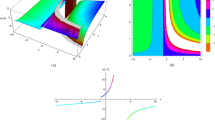Abstract
One of the crucial issues in engineering problem solving is prediction of behavior, namely deriving the behavior from models. Prediction of behavior is not just calculation. Rather, it is an intellectual activity. High level decision making is needed to plan what and how to compute, monitor computation process, and interpret the result. Hence, a large portion of the prediction process has been indebted to human experts.
As a first step towards this end, we concentrate on systems of piecewise linear ordinary differential equations (systems of PWL-ODEs), and proposeFlow Topology Analysis, a computational framework of analyzing systems of PWL-ODEs. We propose abstract representation, calledflow mappings, for describing qualitative aspects of solution curves in regions of the phase space. Flow mappings are used as an interface between knowledge and numerical levels. Currently, we have implemented the idea for systems of PWL-ODEs on two-dimensional phase spaces and partly for those on three-dimensional phase spaces.
Similar content being viewed by others
References
Abelson, H., Eisenberg, M., Halfant, M., Katzenelson, J., Sacks, E., Sussman, G. J., Wisdom, J. and Yip, K., “Intelligence in Scientific Computing,”Communications of the ACM, 32, pp. 546–562, 1989.
Guckenheimer, J. and Holmes, P.,Nonlinear Oscillations, Dynamical Systems, and Bifurcations of Vector Fields, Springer-Verlag, 1983.
Hirsch, M. W. and Smale, S.,Differential Equations, Dynamical Systems, and Linear Algebra, Academic Press, 1974.
Kalagnanam, J., “Integration of Symbolic and Numeric Methods for Qualitative Reasoning,”Technical Report, CMU-EPP-1991-01-01, Engineering and Public Policy, CMU, 1991.
Mizutani, K., “Automated Analysis of Qualitative Behavior of Ordinary Differential Equations in Three-Dimensional Phase Space,”Master thesis, Department of Information Science, Kyoto University, (in Japanese), 1992.
Nishida, T. and Doshita, S., “PSX: A Program that Explores Phase Portraits of Two-Dimensional Piecewise Linear Differential Equations” (unpublished research note, available from the author), 1990.
Nishida, T. and Doshita, S., “A Geometric Approach to Total Envisioning,” inProceedings IJCAI-91, pp. 1150–1155, 1991.
Nishida, T., Mizutani, K., Kubota, A. and Doshita, S., “Automated Phase Portrait Analysis by Integrating Qualitative and Quantitative Analysis,” inProceedings AAAI-91, pp. 811–816, 1991.
Sacks, E. p., “Piecewise Linear Abstraction,” inQualitative Reasoning Workshop Abstracts, Qualitative Reasoning Group, University of Illinois at Urbana-Champaign, 1987.
Sacks, E. P., “Automatic Qualitative Analysis of Dynamic Systems Using Piecewise Linear Approximations,”Artificial Intelligence, 41. pp, 313–364, 1990.
Sacks, E. P., “Automatic Analysis of One-Parameter Planar Ordinary Differential Equations by Intelligent Numeric Simulation,”Artificial Intelligence, 48, pp. 27–56, 1991.
Wolfram, S.,Mathematica—A System for Doing Mathematics by Computer, Addison-Wesley Pub. Co, 1988. (the second edition was published in 1991).
Zhao, F., “Extracting and Representing Qualitative Behaviors of Complex Systems in Phase Spaces,” inProceedings IJCAI-91, pp. 1144–1149, 1991.
Author information
Authors and Affiliations
Additional information
Toyoaki Nishida, Ph. D.: He was born in 1954. He received the B. E., the M. E., and the Doctor of Engineering degrees from Kyoto University in 1977, 1979, and 1984 respectively. In 1980, he joined Department of Information Science, Kyoto University as an assistant professor. Now he is an associate professor. From April 1984 to March 1985, he was a visiting scientist at Department of Computer Science, Yale University. His research interest covers qualitative physics and knowledge sharing and reuse, important sub-fields of artificial intelligence.
Kenji Mizutani: He was born in 1968. He received the B. E. and the M. E. degrees from Kyoto University in 1990 and 1992 respectively. In 1989–1990, he designed the hardware architecture of the parallel reduction machine for logic programming languages. In 1990–1992, he researched on automating the analysis of the qualitative behavior of ordinary differential equations. Since 1992, he has been working at Central Research Laboratory, Matsushita Electric Industrial Co., Ltd. His research interest is natural language processing. He is presently researching and developing a discourse understanding system.
Shuji Doshita, Ph. D.: He was born in 1935. He received the Bachelor, Master and Doctor of Engineering from Kyoto University in 1958, 1960, 1966, respectively, on speech recognition. He joined Department of Electrical Engineering, Kyoto University as Assistant Professor in 1963, as Associate Professor in 1965, and Department of Electro-Physical Engineering, Tokyo Institute of Technology as Associate Professor in 1968. Now he is Professor of Department of Information Science, Kyoto University. He was Science Advisor of Ministry of Education of Japan from 1986 to 1989 and currently Vice-President of Japanese Society for Artificial Intelligence (JSAI). His current interest covers artificial intelligence and intelligent information processing, especially speech recognition, natural language understanding, dialogue understanding.
About this article
Cite this article
Nishida, T., Mizutani, K. & Doshita, S. Automated analysis of qualitative behaviors of piecewise linear ordinary differential equations. New Gener Comput 11, 159–177 (1993). https://doi.org/10.1007/BF03037157
Received:
Revised:
Issue Date:
DOI: https://doi.org/10.1007/BF03037157




